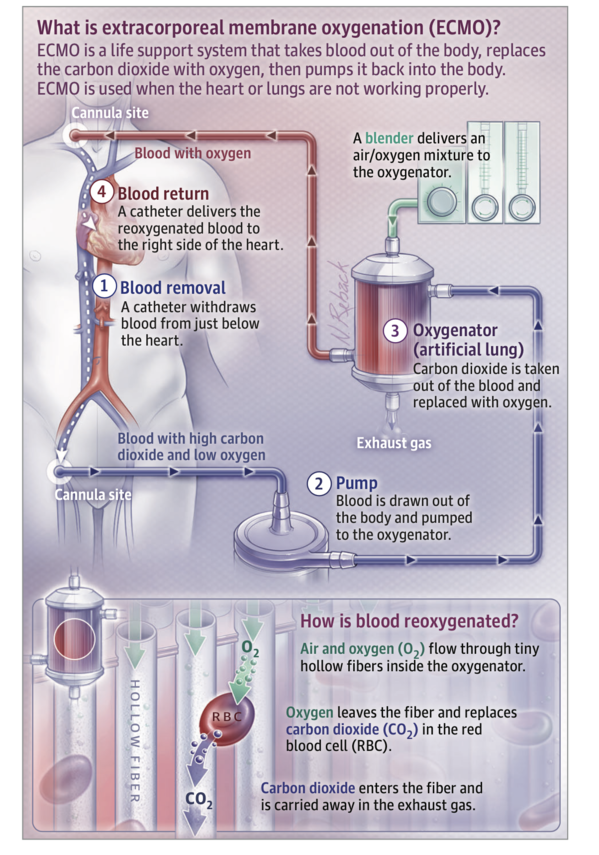Extracorporeal membrane oxygenation (ECMO) is used to treat patients with severe, life-threatening conditions of the heart and lungs.
ECMO uses a pump to replace the function of the heart while an oxygenator performs the work of the lungs. ECMO provides short-term support, giving the heart and lungs time to recover.
Why Is ECMO Used?
* Cardiogenic shock: The heart is unable to pump adequate blood to meet the body's demand. This may result from a heart attack, heart failure, pulmonary embolism, or severe infection.
* Respiratory failure: The lungs cannot properly exchange oxygen for carbon dioxide. This may occur because of chronic lung disease, severe infections including influenza or pneumonia, or acute lung inflammation (acute respiratory distress syndrome).
* Postoperative heart failure: After heart surgery, it can take time for the heart to recover, and ECMO may be used until it does.
* Extracorporeal cardiopulmonary resuscitation (CPR): In specialized centers, ECMO is started during cardiac arrest as part of CPR. Studies examining the outcomes of this usage are under way.
* Awaiting heart or lung transplant: Some patients require ECMO while waiting for an organ transplant.
How Does ECMO Work?
Large plastic tubes called cannulas are placed in veins or arteries in the legs, neck, or chest and are connected to an ECMO machine. Blood passes through these tubes out of a patient's body and through an oxygenator, where oxygen is added to the blood and carbon dioxide is removed before the blood is returned to the patient.
Complications of ECMO
ECMO is temporary and there may be serious risks.
* Bleeding: Blood thinners are used to prevent clots from forming in the tubing that carries the blood. Bleeding is the most common complication of ECMO and can be life-threatening if it occurs in the brain, lungs, or gastrointestinal tract. Patients receiving ECMO commonly require blood transfusions.
* Stroke: Clots may form in the ECMO circuit or body and cause a stroke. This rarely happens, but it can be disabling or fatal.
* Leg injury: When cannulas are placed in vessels in the leg, blood flow to the lower portion of the leg may be compromised. This may require surgery or amputation.
Why Don't All Patients Improve With ECMO?
Some patients may not improve if their disease is not reversible or does not respond to treatment. Certain diseases may lead to progressive organ dysfunction, such as liver failure or severe neurologic injury. These conditions have a poor prognosis and may warrant discussion about discontinuing ECMO support.
ECMO (JAMA 2020.05.28)
体外式膜型人工肺(Extracorporeal membrane oxygenation, ECMO)は、心臓と肺の重度で生命を脅かす状態の患者の治療に使用される。
ECMOは、酸素吸入器が肺の働きをしている間、ポンプを使用して心臓の機能を代替する。ECMOは、心臓と肺に回復のための時間を与え、短期的なサポートを提供する。
なぜECMOが使用されるのか?
* 心原性ショック:心臓が体の要求を満たすために十分な血液を送り出すことができない状態である。これは、心臓発作、心不全、肺塞栓症、または重度の感染症が原因となる。
* 呼吸不全:肺が適切に酸素と二酸化炭素を交換できない状態。慢性肺疾患、インフルエンザや肺炎などの重度の感染症、急性の肺炎症(急性呼吸窮迫症候群)などが原因で起こることがある。
* 心臓手術後の心不全:心臓の手術後、心臓が回復するまで時間がかかることがあり、回復するまでECMOを使用することがある。
* 体外心肺蘇生法(CPR)。専門のセンターでは、心停止中に心肺蘇生法の一部としてECMOを開始する。この方法の有用性を検証する研究が進行中である。
* 心臓移植または肺移植待機中の患者。臓器移植を待っている間にECMOを必要とする患者もいる。
ECMOはどのように機能するのか?
足や首、胸の静脈や動脈にカニューレと呼ばれる大きなプラスチック製のチューブを入れ、ECMO装置に接続する。血液は患者の体からこのチューブを通って酸素供給装置を通り、血液に酸素が加えられ、二酸化炭素が除去されてから患者さんに戻される。
ECMOの合併症
ECMOは一時的な治療法であり、重大なリスクがあるかもしれない。
* 出血:血液を運ぶチューブに血栓ができるのを防ぐために、血液凝固薬が使用される。出血はECMOの最も頻度の高い合併症であり、脳、肺、消化管で発生した場合には生命を脅かす可能性がある。ECMOを受けている患者は、一般的に輸血を必要とする。
* 脳卒中:ECMOの回路や体内に血栓が形成され、脳卒中を引き起こすことがあります。稀に起こることもあるが、機能障害を起こしたり、致命的になることもある。
* 下肢の損傷:下肢の血管にカニューレを挿入すると、下肢の血流が悪くなることがあります。手術や切断が必要になることもある。
なぜすべての患者さんがECMOで改善しないのか?
疾患が可逆的でなかったり、治療に反応しない場合、改善しない患者もいる。疾患によっては、肝不全や重度の神経障害など、進行性の臓器機能障害を引き起こすことがある。これらの疾患は予後が悪く、ECMOのサポートを中止することを検討する必要があるかもしれない。
